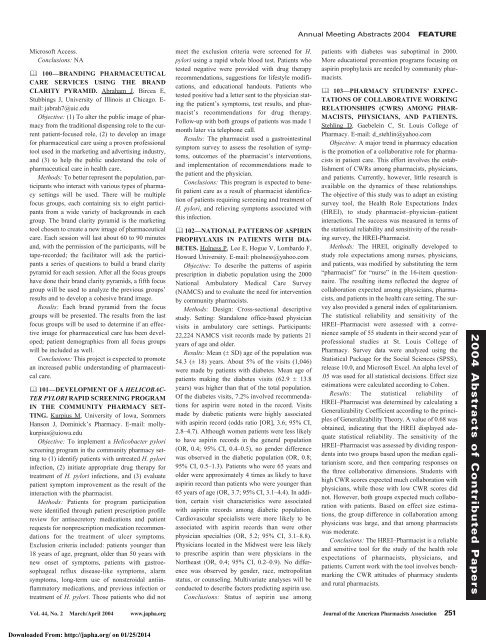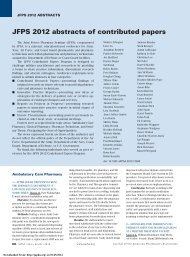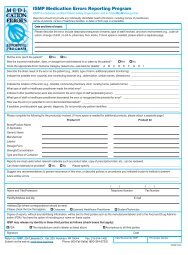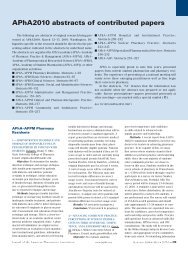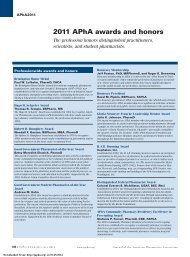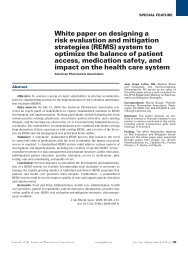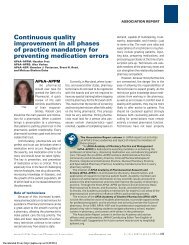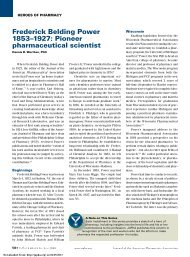Downloaded - Journal of American Pharmacists Association
Downloaded - Journal of American Pharmacists Association
Downloaded - Journal of American Pharmacists Association
You also want an ePaper? Increase the reach of your titles
YUMPU automatically turns print PDFs into web optimized ePapers that Google loves.
Annual Meeting Abstracts 2004<br />
FEATURE<br />
Micros<strong>of</strong>t Access.<br />
Conclusions: NA<br />
100—BRANDING PHARMACEUTICAL<br />
CARE SERVICES USING THE BRAND<br />
CLARITY PYRAMID. Abraham J, Bircea E,<br />
Stubbings J, University <strong>of</strong> Illinois at Chicago. E-<br />
mail: jabrah7@uic.edu<br />
Objective: (1) To alter the public image <strong>of</strong> pharmacy<br />
from the traditional dispensing role to the current<br />
patient-focused role, (2) to develop an image<br />
for pharmaceutical care using a proven pr<strong>of</strong>essional<br />
tool used in the marketing and advertising industry,<br />
and (3) to help the public understand the role <strong>of</strong><br />
pharmaceutical care in health care.<br />
Methods: To better represent the population, participants<br />
who interact with various types <strong>of</strong> pharmacy<br />
settings will be used. There will be multiple<br />
focus groups, each containing six to eight participants<br />
from a wide variety <strong>of</strong> backgrounds in each<br />
group. The brand clarity pyramid is the marketing<br />
tool chosen to create a new image <strong>of</strong> pharmaceutical<br />
care. Each session will last about 60 to 90 minutes<br />
and, with the permission <strong>of</strong> the participants, will be<br />
tape-recorded; the facilitator will ask the participants<br />
a series <strong>of</strong> questions to build a brand clarity<br />
pyramid for each session. After all the focus groups<br />
have done their brand clarity pyramids, a fifth focus<br />
group will be used to analyze the previous groups’<br />
results and to develop a cohesive brand image.<br />
Results: Each brand pyramid from the focus<br />
groups will be presented. The results from the last<br />
focus groups will be used to determine if an effective<br />
image for pharmaceutical care has been developed;<br />
patient demographics from all focus groups<br />
will be included as well.<br />
Conclusions: This project is expected to promote<br />
an increased public understanding <strong>of</strong> pharmaceutical<br />
care.<br />
101—DEVELOPMENT OF A HELICOBAC-<br />
TER PYLORI RAPID SCREENING PROGRAM<br />
IN THE COMMUNITY PHARMACY SET-<br />
TING. Kurpius M, University <strong>of</strong> Iowa, Sommers<br />
Hanson J, Dominick’s Pharmacy. E-mail: mollykurpius@uiowa.edu<br />
Objective: To implement a Helicobacter pylori<br />
screening program in the community pharmacy setting<br />
to (1) identify patients with untreated H. pylori<br />
infection, (2) initiate appropriate drug therapy for<br />
treatment <strong>of</strong> H. pylori infections, and (3) evaluate<br />
patient symptom improvement as the result <strong>of</strong> the<br />
interaction with the pharmacist.<br />
Methods: Patients for program participation<br />
were identified through patient prescription pr<strong>of</strong>ile<br />
review for antisecretory medications and patient<br />
requests for nonprescription medication recommendations<br />
for the treatment <strong>of</strong> ulcer symptoms.<br />
Exclusion criteria included: patients younger than<br />
18 years <strong>of</strong> age, pregnant, older than 50 years with<br />
new onset <strong>of</strong> symptoms, patients with gastroesophageal<br />
reflux disease-like symptoms, alarm<br />
symptoms, long-term use <strong>of</strong> nonsteroidal antiinflammatory<br />
medications, and previous infection or<br />
treatment <strong>of</strong> H. pylori. Those patients who did not<br />
meet the exclusion criteria were screened for H.<br />
pylori using a rapid whole blood test. Patients who<br />
tested negative were provided with drug therapy<br />
recommendations, suggestions for lifestyle modifications,<br />
and educational handouts. Patients who<br />
tested positive had a letter sent to the physician stating<br />
the patient’s symptoms, test results, and pharmacist’s<br />
recommendations for drug therapy.<br />
Follow-up with both groups <strong>of</strong> patients was made 1<br />
month later via telephone call.<br />
Results: The pharmacist used a gastrointestinal<br />
symptom survey to assess the resolution <strong>of</strong> symptoms,<br />
outcomes <strong>of</strong> the pharmacist’s interventions,<br />
and implementation <strong>of</strong> recommendations made to<br />
the patient and the physician.<br />
Conclusions: This program is expected to benefit<br />
patient care as a result <strong>of</strong> pharmacist identification<br />
<strong>of</strong> patients requiring screening and treatment <strong>of</strong><br />
H. pylori, and relieving symptoms associated with<br />
this infection.<br />
102—NATIONAL PATTERNS OF ASPIRIN<br />
PROPHYLAXIS IN PATIENTS WITH DIA-<br />
BETES. Holness P, Lee E, Hogue V, Lombardo F,<br />
Howard University. E-mail: pholness@yahoo.com<br />
Objective: To describe the patterns <strong>of</strong> aspirin<br />
prescription in diabetic population using the 2000<br />
National Ambulatory Medical Care Survey<br />
(NAMCS) and to evaluate the need for intervention<br />
by community pharmacists.<br />
Methods: Design: Cross-sectional descriptive<br />
study. Setting: Standalone <strong>of</strong>fice-based physician<br />
visits in ambulatory care settings. Participants:<br />
22,224 NAMCS visit records made by patients 21<br />
years <strong>of</strong> age and older.<br />
Results: Mean (± SD) age <strong>of</strong> the population was<br />
54.3 (± 18) years. About 5% <strong>of</strong> the visits (1,046)<br />
were made by patients with diabetes. Mean age <strong>of</strong><br />
patients making the diabetes visits (62.9 ± 13.8<br />
years) was higher than that <strong>of</strong> the total population.<br />
Of the diabetes visits, 7.2% involved recommendations<br />
for aspirin were noted in the record. Visits<br />
made by diabetic patients were highly associated<br />
with aspirin record (odds ratio [OR], 3.6; 95% CI,<br />
2.8–4.7). Although women patients were less likely<br />
to have aspirin records in the general population<br />
(OR, 0.4; 95% CI, 0.4–0.5), no gender difference<br />
was observed in the diabetic population (OR, 0.8;<br />
95% CI, 0.5–1.3). Patients who were 65 years and<br />
older were approximately 4 times as likely to have<br />
aspirin record than patients who were younger than<br />
65 years <strong>of</strong> age (OR, 3.7; 95% CI, 3.1–4.4). In addition,<br />
certain visit characteristics were associated<br />
with aspirin records among diabetic population.<br />
Cardiovascular specialists were more likely to be<br />
associated with aspirin records than were other<br />
physician specialties (OR, 5.2; 95% CI, 3.1–8.8).<br />
Physicians located in the Midwest were less likely<br />
to prescribe aspirin than were physicians in the<br />
Northeast (OR, 0.4; 95% CI, 0.2–0.9). No difference<br />
was observed by gender, race, metropolitan<br />
status, or counseling. Multivariate analyses will be<br />
conducted to describe factors predicting aspirin use.<br />
Conclusions: Status <strong>of</strong> aspirin use among<br />
patients with diabetes was suboptimal in 2000.<br />
More educational prevention programs focusing on<br />
aspirin prophylaxis are needed by community pharmacists.<br />
103—PHARMACY STUDENTS’ EXPEC-<br />
TATIONS OF COLLABORATIVE WORKING<br />
RELATIONSHIPS (CWRS) AMONG PHAR-<br />
MACISTS, PHYSICIANS, AND PATIENTS.<br />
Stehling D, Gaebelein C, St. Louis College <strong>of</strong><br />
Pharmacy. E-mail: d_stehlin@yahoo.com<br />
Objective: A major trend in pharmacy education<br />
is the promotion <strong>of</strong> a collaborative role for pharmacists<br />
in patient care. This effort involves the establishment<br />
<strong>of</strong> CWRs among pharmacists, physicians,<br />
and patients. Currently, however, little research is<br />
available on the dynamics <strong>of</strong> these relationships.<br />
The objective <strong>of</strong> this study was to adapt an existing<br />
survey tool, the Health Role Expectations Index<br />
(HREI), to study pharmacist–physician–patient<br />
interactions. The success was measured in terms <strong>of</strong><br />
the statistical reliability and sensitivity <strong>of</strong> the resulting<br />
survey, the HREI-Pharmacist.<br />
Methods: The HREI, originally developed to<br />
study role expectations among nurses, physicians,<br />
and patients, was modified by substituting the term<br />
“pharmacist” for “nurse” in the 16-item questionnaire.<br />
The resulting items reflected the degree <strong>of</strong><br />
collaboration expected among physicians, pharmacists,<br />
and patients in the health care setting. The survey<br />
also provided a general index <strong>of</strong> egalitarianism.<br />
The statistical reliability and sensitivity <strong>of</strong> the<br />
HREI–Pharmacist were assessed with a convenience<br />
sample <strong>of</strong> 55 students in their second year <strong>of</strong><br />
pr<strong>of</strong>essional studies at St. Louis College <strong>of</strong><br />
Pharmacy. Survey data were analyzed using the<br />
Statistical Package for the Social Sciences (SPSS),<br />
release 10.0, and Micros<strong>of</strong>t Excel. An alpha level <strong>of</strong><br />
.05 was used for all statistical decisions. Effect size<br />
estimations were calculated according to Cohen.<br />
Results: The statistical reliability <strong>of</strong><br />
HREI–Pharmacist was determined by calculating a<br />
Generalizability Coefficient according to the principles<br />
<strong>of</strong> Generalizability Theory. A value <strong>of</strong> 0.68 was<br />
obtained, indicating that the HREI displayed adequate<br />
statistical reliability. The sensitivity <strong>of</strong> the<br />
HREI–Pharmacist was assessed by dividing respondents<br />
into two groups based upon the median egalitarianism<br />
score, and then comparing responses on<br />
the three collaborative dimensions. Students with<br />
high CWR scores expected much collaboration with<br />
physicians, while those with low CWR scores did<br />
not. However, both groups expected much collaboration<br />
with patients. Based on effect size estimations,<br />
the group difference in collaboration among<br />
physicians was large, and that among pharmacists<br />
was moderate.<br />
Conclusions: The HREI–Pharmacist is a reliable<br />
and sensitive tool for the study <strong>of</strong> the health role<br />
expectations <strong>of</strong> pharmacists, physicians, and<br />
patients. Current work with the tool involves benchmarking<br />
the CWR attitudes <strong>of</strong> pharmacy students<br />
and rural pharmacists.<br />
2004 Abstracts <strong>of</strong> Contributed Papers<br />
Vol. 44, No. 2 March/April 2004 www.japha.org <strong>Journal</strong> <strong>of</strong> the <strong>American</strong> <strong>Pharmacists</strong> <strong>Association</strong> 251<br />
<strong>Downloaded</strong> From: http://japha.org/ on 01/25/2014


